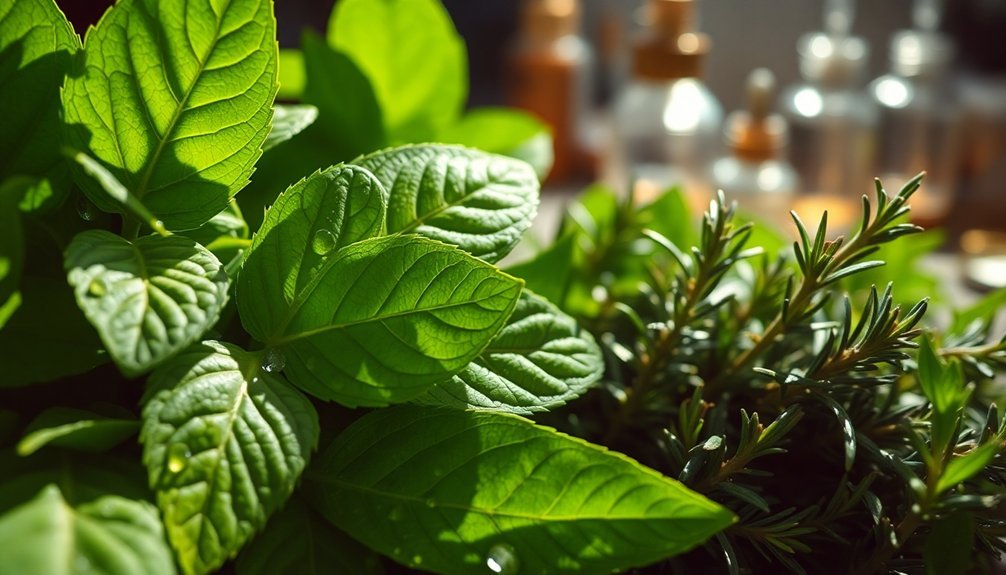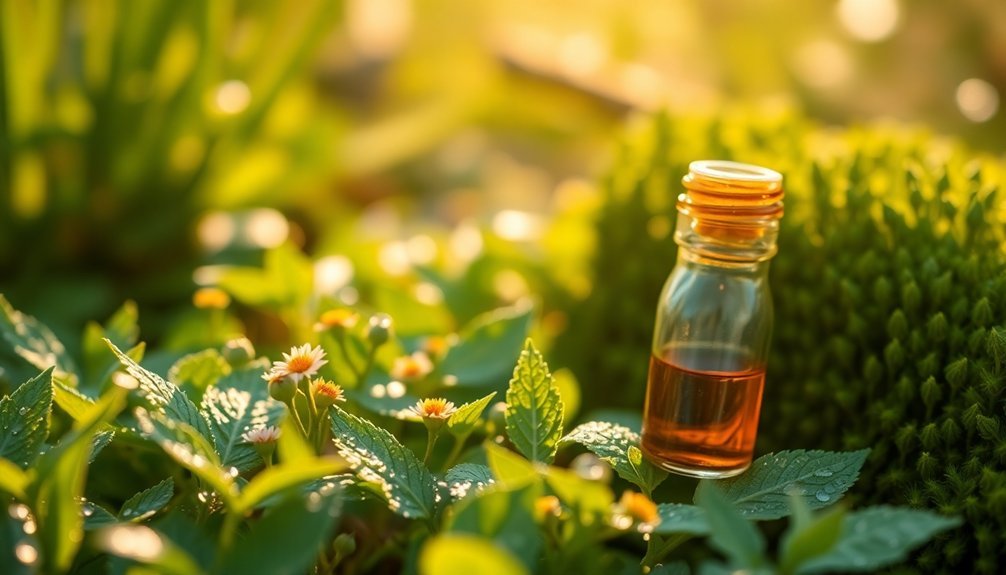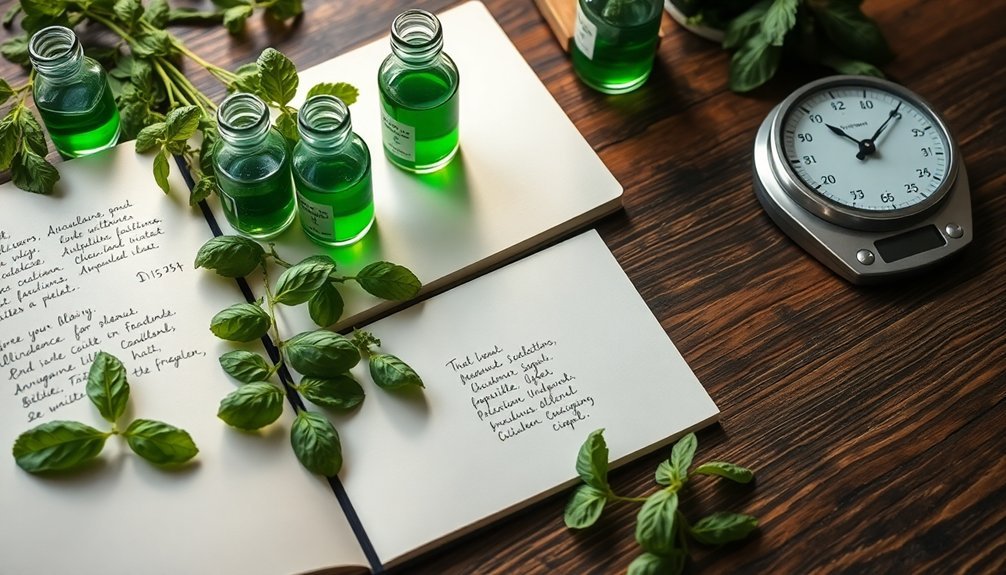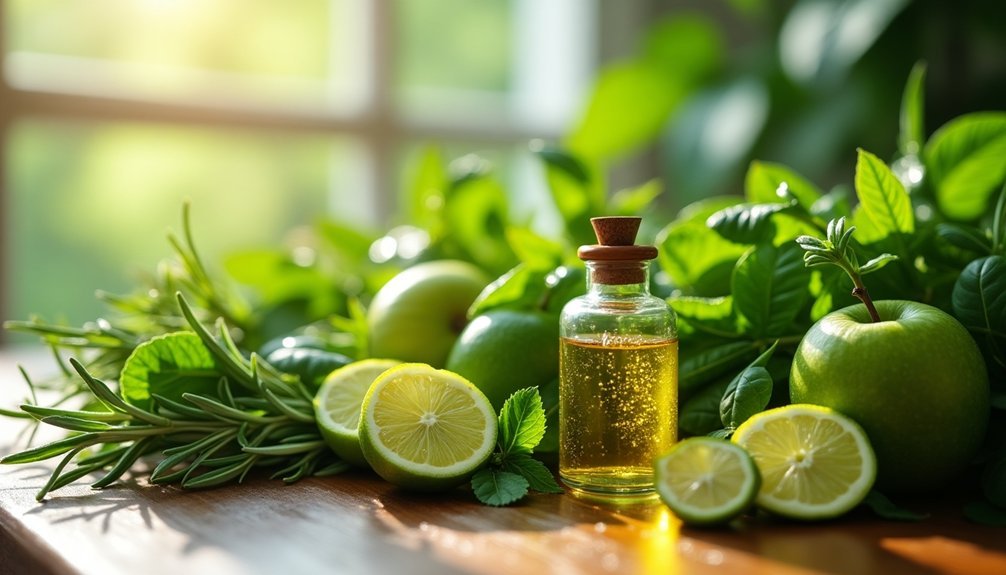Fresh green scents can transform your perfume blends into vibrant botanical creations. Start with natural ingredients like galbanum and violet leaf, then incorporate synthetic elements like cis-3-Hexenol for authentic grassy notes. You'll want to use the drop-by-drop technique, maintaining precise measurements and detailed records. Balance your green notes with citrus elements and fix them with patchouli or vetiver. The world of green perfumery opens up endless possibilities for your signature scents.
Understanding the Core Green Note Ingredients

While green notes form the backbone of many fresh fragrances, understanding their core ingredients is essential for successful perfume blending.
You'll find both natural and synthetic sources that can create the perfect green accord. Natural ingredients like galbanum provide earthy, bitter nuances, while violet leaf offers a fresh, metallic character. Fig leaf and green tea add subtle, fruity dimensions to your compositions.
For stability and enhancement, you'll want to incorporate synthetic molecules like cis-3-Hexenol and alil amog glycolate. These compounds effectively mimic fresh-cut grass and ivy leaves while ensuring your green notes last longer.
When working with these ingredients, remember they're most effective as top or middle notes, and you can combine them with citrus, floral, or chypre elements for added complexity. Small amounts of green ingredients can produce significant fragrance impacts while maintaining balance in your blend.
Mastering the Drop-by-Drop Blending Technique
Once you've familiarized yourself with the essential oil components, mastering the drop-by-drop blending technique becomes your next crucial step in perfumery.
Start by adding a single drop of your base note to a stock bottle, then incorporate your middle note, followed by the top note. Keeping a detailed journal log during your blending process will help maintain consistency and repeatability. You'll want to swirl gently and assess the aroma after each addition.
Consider working with common ratios like 3:2:1 or 4:2:1 (top:middle:base), but don't feel bound by strict formulas. Use pipettes for precise measurements and keep detailed notes of your process.
Remember to take breaks and use coffee beans to reset your sense of smell. Let your blend rest for 24 hours to allow the scents to meld properly.
Always dilute your final creation in carrier oil, maintaining a maximum 5% essential oil concentration.
Balancing Green Notes With Citrus Elements

Building on your drop-by-drop technique, let's explore the artful balance of green notes with citrus elements. These natural synergistic partners create vibrant, invigorating fragrances that'll energize your compositions. The cold pressing technique ensures your citrus oils maintain their bright, zesty character in the final blend.
You'll find that adding green notes to citrus can transform a simple scent into something sophisticated and dynamic.
- Start with light citrus oils like bergamot or lemon, then layer in green notes for depth.
- Balance sweet elements by incorporating green mandarin to prevent overwhelming sugar notes.
- Consider adding mint or basil to amplify the fresh factor in your citrus blends.
- Experiment with woody base notes like cedarwood, using green notes to maintain brightness.
When blending, remember that green notes can enhance florals, balance gourmands, and freshen woody bases – making them incredibly versatile in your perfumery toolkit.
Creating Natural Leaf and Grass Accords
The art of creating natural leaf and grass accords requires a delicate balance of powerful green ingredients.
You'll want to start with small percentages of key components like galbanum for the initial burst of greenery and violet leaf for crisp freshness.
Add trace amounts of cucumber aldehyde or hexenal to capture that authentic cut grass smell.
To enhance realism, combine different green notes at varying levels.
Try mixing basil and ivy leaves with stemoné to create depth, then soften the blend with subtle floral undertones.
You can achieve a more complex profile by incorporating vetiver or green tea elements.
Remember that most green ingredients are potent, so stick to concentrations of 1% or less.
For added authenticity, consider working with natural ingredients experts to fine-tune your green accord.
Incorporating Herbal Elements Into Green Blends

While mastering green accords forms a solid foundation, adding herbal elements can transform your blend into a more complex and authentic creation.
You'll find that ingredients like galbanum oil and violet leaf absolute provide an excellent base for incorporating herbal depth. For the best results, combine these with leaf alcohols like Hexenol 3-Cis to enhance freshness and natural qualities.
- Start with galbanum oil at 1% concentration to establish your green base
- Layer in cucumber extract for a crisp, light dimension
- Add sage or lavender to create a soothing herbal touch
- Finish with violet leaf absolute for earthy, leafy undertones
Don't forget to balance your herbal elements with woody notes like patchouli or vetiver for added depth.
For stability, synthetic molecules like cis-3-Hexenol can help anchor your natural ingredients.
Achieving Harmony Between Green and Floral Notes
Successfully combining green and floral notes requires a delicate balance of concentration and timing in your composition. You'll find that green notes work best in trace amounts, allowing floral elements to shine through without being overwhelmed.
| Green Note | Floral Partner | Effect |
|---|---|---|
| Galbanum | White Flowers | Earthy depth |
| Violet Leaves | Rose | Soft persistence |
| Green Tea | Jasmine | Refined crispness |
| Cut Grass | Light Florals | Natural energy |
When blending, start with green notes in the top notes for a bright opening, then layer in florals for the heart. You'll create more sophisticated compositions by pairing galbanum with white flowers or violet leaves with rose. For a subtle approach, try green tea with delicate florals, or experiment with basil and mint to add a revitalizing lift to your floral arrangements.
Essential Fixatives for Green Compositions

Creating lasting green compositions requires careful selection of fixatives to anchor their naturally ephemeral character.
You'll find both natural and synthetic options that can greatly enhance the longevity of your green fragrances while maintaining their fresh character.
- Use patchouli or vetiver essential oils to add depth and staying power, especially when working with herbaceous accords.
- Incorporate modern synthetics like Iso E Super or Hedione to lift and extend delicate green notes while adding smoothness.
- Consider natural resins like labdanum or benzoin to stabilize green notes while introducing warmth and richness.
- Explore sustainable alternatives such as Polycitronellol or Triethyl Citrate for an eco-friendly approach to fixing your green compositions.
Experiment with combinations of these fixatives to achieve the perfect balance between longevity and maintaining the crisp, fresh qualities of your green notes.
Proper Storage and Aging of Green Fragrances
Once you've mastered the art of blending green fragrances, proper storage becomes your next priority.
Keep your creations in a cool, dark environment between 60-70°F to preserve their delicate compositions. You'll want to avoid placing them near heaters, sunny windows, or humid bathrooms where temperature fluctuations can alter their chemical makeup.
Store your green blends in airtight containers, preferably in their original packaging, and seal them tightly after each use to prevent oxidation.
For valuable compositions, consider using a dedicated refrigerator or a dehumidified storage space. Double-pack precious blends in airtight bags within their original boxes for maximum protection.
Remember to keep your fragrances on low-level shelves to prevent accidents, and always protect them from both natural and artificial light sources.
Measuring and Recording Your Green Blends

Capturing your green fragrance blends requires meticulous drop-by-drop documentation and proper measuring tools.
You'll need quality droppers and a digital scale to measure each oil accurately, whether you're working with single drops or weight measurements in ounces.
Recording each ingredient's exact amount in a dedicated logbook guarantees you can replicate successful blends and adjust ratios for future formulations.
Accurate Drop-by-Drop Documentation
Accurate measurement and documentation form the bedrock of successful perfume blending. When you're working with drops, convert them to weight measurements for precision and repeatability.
You'll want to scale up your formulas to at least 100 drops total, ensuring no ingredient gets less than two drops in the mix.
Use an electronic balance that measures to 0.001 grams and record everything in a detailed spreadsheet. Here's what you'll need to track:
- Exact concentration and weight of each ingredient
- Adjustments made to reach desired total concentration
- Sample evaluations and modifications
- Dilution ratios with ethanol
Take regular breaks to avoid olfactory fatigue while blending. Don't smell ingredients incrementally – this can bias your perception.
Instead, evaluate your blends on scent strips for an unbiased assessment of your green fragrance creation.
Essential Tools For Measurement
Building on proper documentation practices, you'll need specific measuring tools to create consistent and reliable green perfume blends.
Start with quality glass measuring cylinders and borosilicate beakers for accurate liquid measurements. You'll want digital scales that measure to the hundredths place (0.00) – even an inexpensive 100-gram scale will work for beginners.
Temperature control is essential, so invest in reliable thermometers to monitor your blending process.
Don't forget essential accessories like stainless steel funnels for clean transfers and droppers for precise ingredient addition. For working with thick aromatics like labdanum, wax-carving tools are invaluable.
If you're planning to separate essential oils from hydrosols, a separatory funnel is a must-have. Consider adding a conductivity meter to measure oil saturation in alcohol accurately.
Building a Green Notes Reference Library
Building your green notes reference library starts with gathering essential samples like galbanum, Cis 3 hexenol, and green tea accords in clearly labeled, dark glass vials.
You'll want to organize these materials systematically, perhaps by natural versus synthetic origins, and store them in a cool, dark place to maintain their integrity.
Document your impressions of each note through regular testing sessions, recording characteristics like intensity, longevity, and how they interact with other fragrance elements.
Essential Green Note Selections
A well-curated collection of green notes forms the backbone of any perfumer's reference library.
You'll want to start with both natural and synthetic materials to create versatile green accords. Galbanum and violet leaf absolute are essential natural ingredients that'll give you authentic leafy, earthy profiles. For cost-effective alternatives, include synthetics like cis-3 hexenol and cucumber aldehyde.
Here's what you'll need in your essential green notes collection:
- Natural galbanum resin for deep, earthy green notes
- Violet leaf absolute for fresh, dewy foliage effects
- Herbal essentials like rosemary, lavender, and thyme
- Key synthetics including cis-3 hexenol and cucumber aldehyde
Mix these materials with citrus, florals, or woody notes to create everything from fresh spring scents to sophisticated green chypres.
Storage and Organization Tips
Four key principles guide the proper storage and organization of your green notes collection.
First, store your fragrances in a cool, dark place away from sunlight and heat to preserve their integrity. You'll want to keep bottles tightly sealed and in their original packaging to prevent oxidation.
Second, categorize your green notes by scent families and intensity levels. This makes it easier to locate specific fragrances when you're blending.
Third, implement a clear labeling system using handwritten or printed tags, and maintain a digital inventory to track expiration dates and usage patterns.
Finally, display your collection thoughtfully using dedicated storage solutions, and rotate placement regularly.
Remember to declutter periodically, removing expired or unused fragrances to maintain an efficient and organized workspace for your perfumery projects.
Testing and Documentation Methods
To develop a complete green notes reference library, you'll need systematic testing and thorough documentation methods.
Start by testing each green note at various dilutions, comparing them side by side, and conducting blind tests to maintain objectivity. Document each note's characteristics, including its intensity, longevity, and blending behavior.
Create detailed profiles for essential green ingredients like:
- Galbanum – earthy and bitter nuances for green chypres
- Green Tea – delicate freshness with leafy undertones
- Violet Leaf – astringent green for floral realism
- Cy 3 Hexanol – fresh-cut grass in trace amounts
Record how your green notes interact with other components and document successful accords.
Don't forget to note the seasonal associations and emotional responses each green note evokes. This systematic approach will help you build a reliable reference for future formulations.
Frequently Asked Questions
How Long Do Green Note Fragrances Typically Last on Skin?
You'll typically experience green note fragrances for 30-60 minutes on your skin, though this can vary based on your skin type, climate, and application method. Oily skin tends to hold these scents longer.
Can Synthetic Green Notes Cause Allergic Reactions More Than Natural Ones?
Yes, you're more likely to experience allergic reactions from synthetic green notes than natural ones. They can trigger skin irritation, rashes, and other allergic responses, while natural alternatives typically pose fewer risks to sensitive individuals.
What Temperature Should Green Note Ingredients Be Stored At?
You'll want to store your green note ingredients between 60-77°F (15-25°C), at room temperature. Keep them in a cool, dark place and avoid temperature fluctuations that could damage their scent composition.
Why Do Some Green Notes Turn Brown or Yellow Over Time?
Your green notes turn brown or yellow due to oxidation reactions when they're exposed to oxygen, light, and heat. These factors break down the volatile organic compounds, causing their chemical structure to degrade over time.
Are Green Notes More Challenging to Work With in Oil-Based Perfumes?
You'll find green notes particularly challenging in oil-based perfumes because they're harder to stabilize and dissolve properly. They can also separate more easily and lose their freshness when mixed with carrier oils.
In Summary
You're now equipped to create vibrant green perfume blends that capture nature's essence. Remember to start with small batches, keep detailed notes, and trust your nose as you experiment. Don't be afraid to combine unexpected elements – that's how unique fragrances are born. With practice and patience, you'll master the art of green perfumery and develop your own signature botanical scents.
References
- https://www.pairfum.com/enigmatic-green-smell-in-perfumery/
- https://theherbalacademy.com/blog/how-to-create-simple-perfume-blends-using-aromatic-notes/
- https://www.youtube.com/watch?v=vjT1lacEnEA
- https://www.perfumestars.com/perfume-notes/green-notes/
- https://salvatorebattaglia.com.au/blogs/news/part-iii-perfume-blending-technique
- https://scentxplore.com/scentxpress-green-scents/
- https://www.fragrenza.com/blogs/notes-in-perfumery/green-note-in-perfumery
- https://africaimports.com/blog/the-ultimate-guide-to-making-perfume-with-essential-oils/
- https://www.youtube.com/watch?v=okVX–qh-pk
- https://achs.edu/blog/blending-101-the-art-of-pairing/





Leave a Reply